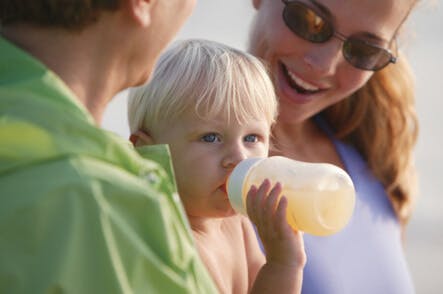Baby Bottle Tooth Decay Defined

Question
What is baby bottle tooth decay and how can I avoid it in my one year old son? This is a great service! Thank you!
San Anselmo, California
Dr. Greene's Answer
Your question comes at a great time. Most of the problems associated with falling asleep with a bottle begin to emerge after a child is one year old.
Cavities result from the interaction between normal mouth bacteria and carbohydrates in the diet. The sugars are converted to acids as they are fermented by the bacteria. The acid then etches the enamel of the teeth if there is prolonged contact. Saliva helps to prevent cavities by digesting the sugars and by washing the teeth.
When one falls asleep, saliva production decreases rapidly. Swallowing also decreases, and liquids present in the mouth at the time of falling asleep tend to pool for long periods.
Baby-bottle tooth decay is the specific form of severe decay found in the teeth of infants and toddlers who fall asleep with a bottle of milk, juice, or any sweetened liquid in the mouth. It is the only severe dental disease common in children under three years of age.
Unlike adult cavities, which are largely invisible, baby-bottle tooth decay causes cavities on the visible portion of the front teeth. The top four central teeth are the ones affected. Their counterparts in the lower gum, protected by the tongue during sucking and washed by saliva, usually remain sound.
The process of tooth decay is quite gradual. Over time the teeth are weakened. Usually, the enamel is finally breached sometime between 12 and 18 months of age. The cavities first appear at the gum line as subtle, white, decalcified streaks. The process then begins to accelerate. In advanced cases, the crowns of the four upper incisors are completely destroyed, leaving decayed brownish-black stumps which distort the spacing of the permanent teeth. I have seen this many, many times.
Cavities may not seem like a big deal, and your son could be happy even with them. But these are the only teeth he will have during the years when much of his personality and self-image are formed. Even though it may seem loving to give him a bottle to go to sleep, it may be more loving to help him fall asleep in other ways.
The most effective way to decrease the risk of baby bottle tooth decay is to avoid giving a child a bottle to fall asleep. If removing the nighttime feed is not possible, keeping a child awake for even fifteen minutes after feeding can significantly help his teeth.
The American Academy of Pediatric Dentistry also recommends starting a dental hygiene routine as soon as a child grows their first tooth. A soft toothbrush or washcloth can be used to clean an infant’s teeth at least twice a day. The AAPD also advises that children see the dentist for the first time at one year of age.


